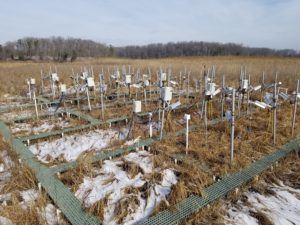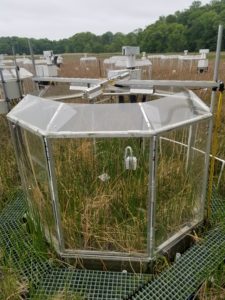Warming Temperatures May Be Better for Wetlands
The Global Change Research Wetland (GCREW), located at the Smithsonian Environmental Research Center (SERC), is home to several long-term experiments designed to predict the effects of sea-level rise and climate change on coastal wetland ecosystems.
Genevieve Noyce, a coastal wetland biogeochemist and research scientist at SERC, works on the SMARTX (Salt Marsh Accretion Response to Temperature eXperiment) project, the newest long-term experiment at GCREW. SMARTX is an ecosystem warming experiment that also includes elevated CO2, allowing her to study wetland responses to the two interlinked factors.

Heated plots after snowfall. The snow has melted off the heated plots, whereas the rest of the marsh (and the ambient temperature plots) are still covered. (Credit: Gary Peresta)
One of the responses to increased warming and CO2 is nitrogen availability. All plants need nitrogen to grow, but most soil is nitrogen limited. The soil microbial process that provides plants with nitrogen becomes more active under warming, so Noyce and her colleagues warmed patches of wetland to simulate a warmer future
Warming soil microbes
Noyce used infrared lamps and underground wires to heat the soil both below and above ground to simulate ecosystem warming. The patches of wetland were heated to be 1.7, 3.4 and 5.1 degrees Celsius (about 3.1, 6.1, and 9.2 degrees Fahrenheit) higher than today . “Chesapeake Bay temperature is estimated to increase between 3 and 5 degrees Celsius and these temperatures mirror these possible futures,” explained Noyce.
“For the most part we expected to see the same effects at all the temperatures,” she said. “There would a small effect at 1.7, and then a little bit bigger at 3.4 and 5.1.” But instead, Noyce was surprised to see a nonlinear response. At the lowest warming (1.7°C), the plants grew more roots than before, meaning they needed more nitrogen and were growing roots to suck it out of the soil. At the hottest temperature (5.1°C higher), that stopped, and root growth returned to normal, but plants saw the biggest total growth in their stems.
The future of wetlands

A heated elevated CO2 chamber (Credit: Genevieve Noyce)
Noyce’s work suggests that a 1.7°C increase could actually be beneficial for wetlands. At that temperature, wetland plants would still feel the need to grow deep roots, stabilizing the soil and increasing their odds of outpacing sea level rise. “1.7 is actually the best case for marsh survival and health it has this bump in productivity and it’s gaining elevation,” explained Noyce.
Temperatures beyond 1.7 °C though and the long-term survival of the marsh may be in question. The increased activity of soil microbes may provide too much free nitrogen to wetland plants. Without the pressure to grow so many roots to capture nitrogen, plants will grow more green stems. However, without these roots help build elevation, wetlands are more susceptible to getting washed away by sea level rise.
